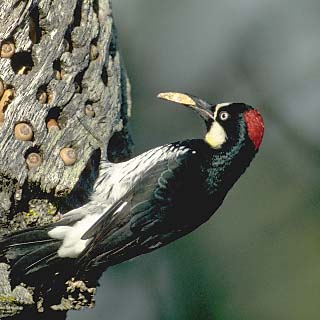Acorn Woodpecker
Category: Woodpeckers

Facts about Acorn Woodpeckers, Scientific name for Acorn Woodpecker is Melanerpes formicivorus". The Acorn Woodpecker is a Melanerpes type of woodpecker that comes from the Picidae family. Scientific name for Woodpecker "Picidae". Acorn Woodpeckers are birds in the Class of "Aves".
There are more than 190 species of woodpeckers worldwide, but none of them are found in polar regions, Madagascar, New Zealand or Australia.The Acorn Woodpeckers are native to the northwestern parts of Oregon in California and they prefer to live in pine-oak forests where they are abundant. The Acorn Woodpecker can also be seen in riparian passages, and in Douglas firs, tropical hardwood and redwood forests where oaks are accessible nearby. The Acorn Woodpecker inhabit urban parks and suburban regions that have many oak trees. The Acorn Woodpeckers are tolerant of humans, and they can be seen where there are acorns and appropriate places to stock them up.
The Acorn Woodpeckers are typically have black color body, with a creamy white face, red color cap, and black colored patch around the bill. During the flight, the Acorn Woodpecker demonstrate three white patches such that one on the rump and one in each wing. Female Acorn Woodpeckers have black striped breast and have crowns that are less red than the crown of male ones. Usually, female breeds are bigger and heavier than male breeds.
The Acorn Woodpecker is an extremely strange bird that lives in huge groups, save acorns, and breed courteously. They collect acorns in groups and lodge them into the holes they have made in the trunk of a tree or in a telephone post. The Acorn Woodpecker also spend substantial time in catching pests on the wing. They often provide harsh, irritating calls. Acorn Woodpecker family groups are how they protect their territory, and the young Acorn Woodpeckers stay with their parents for several years and will help their parents raise other young Acorn Woodpecker. They may breed within one family and can have up to three breeding females and seven breeding males the family group.
Diet
Acorn Woodpeckers used to feed on insects, oak catkins, sap, flower nectar and fruits. The Acorn Woodpecker also feed on grass seeds, bird eggs and lizards. However, their favorite food is flying ants and other Coleoptera and Hymenoptera.
The average lifespan of the Acorn Woodpecker ranges from 5 years to 10 years.
An average Acorn Woodpeckers tongue is up to 4 inches long. The length can be a little different depending on which species of woodpecker. Acorn Woodpecker tongue wraps around the reinforced skull structured and squashy bone, to even out the impact of the pecking force. Acorn Woodpeckers have barbed tongues that helps them remove bugs from holes and tree bark.
Features
The Acorn Woodpecker is an average-sized woodpecker, with a body length, ranging from 7 1/2 inches to 9 7/64 inches (19 to 23.1 cm). They have a body mass that ranges from 2.3 pounds to 3.2 pounds (1 to 1.4 kg). These woodpeckers appear with straight, bills similar to a spike and rigid, tails in the form of a wedge, which are used for support while the birds stick to the trunk of the tree.
Feathers that look like hairs on the Acorn Woodpecker nostrils, prevent ingestion of wood particles.
When feeding, drumming and building a nest cavity, a Acorn Woodpecker can peck up to 20 times per second, wow that's fast! or a total between 9,000 and 12,000 pecks in a day.
Acorn Woodpeckers have a prominent surge in flight comprise of three rapid wing flaps, followed by a quick glide when the Acorn Woodpeckers wings are tucked against its body rather than spread out like many other birds.
Acorn Woodpeckers are omnivores; meaning - an animal that eats food of both animal and plant and origin.
Acorn Woodpeckers possess a protective ocular mechanisms for protecting its eyes from shaking from the pecking impact. Acorn Woodpeckers show a restricted axial globe movement due to the tight fit within the fascial tissue connections and orbit between the sclera and orbital rim.
The eyes of the Acorn Woodpecker are covered with a nictitating membrane (from Latin nictare, to blink)— a translucent and transparent third eyelid - that protects the Acorn Woodpeckers eyes from flying debris while pecking.
Acorn Woodpeckers have zygodactyl feet, having 4 fingers, which means they have two toes facing the front and two toes facing the back, that helps them to have a strong grip on trees vertically. The Acorn Woodpecker use these 8 fingers with their stiff central portion tail feathers to brace on trees as they climb.
Male and female Acorn Woodpeckers are able to drum hollow trees logs execrate. Since woodpeckers do not have vocal cords and don't sing, this pecking activity also plays an important role in communicating with each other. Woodpeckers drumming is also to attract a mate, mark out territory, both sexes are known to drum.

 Back To Category Woodpeckers
Back To Category Woodpeckers